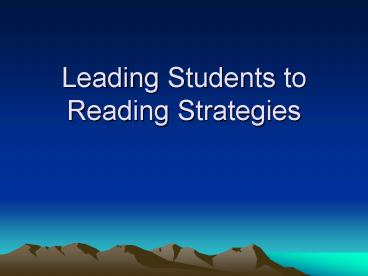Leading Students to Reading Strategies PowerPoint PPT Presentation
1 / 19
Title: Leading Students to Reading Strategies
1
Leading Students to Reading Strategies
2
The Soote Season
- The soote season, that bud and bloom forth
brings, - With green hath clad the hill and eke the vale
- The nightingale with feathers new she sings
- The turtle to her mate hath told her tale.
- Summer is come, for every spray now springs
- The hart hath hung his old head on the pale
- The buck in brake his winter coat he flings,
- The fishes float with new repaired scale
- The adder all her slough away she slings,
- The swift swallow pursueth the flies small
- The busy bee her honey now she mings.
- Winter is worn, that was the flowers bale.
- And thus I see among these pleasant things,
- Each care decays, and yet my sorrow springs.
- Henry Howard, Earl
of Surrey, 1557, - The Norton Anthology of Poetry,
- 4th edition, Norton Company
3
- You the reader were assigned this poem.
- You were asked to read, understand, and interpret
words written in 1557. - --------------------------------------------------
------- - Why?
- Did you care?
- Was it easy?
4
Your process.
- In reading the poem,
- how did you go about it?
5
- Your reaction to this sonnet, if you didnt like
it, or had trouble reading, may be similar to
what a student experiences in looking at dense
text.
6
Old World
- We learn from words.
- Words and sentences are shaped into paragraphs,
each with a point. - Major concepts can take 50 pages or more (read
Moby Dick when do you figure out the whales
role?) - Pictures are there for entertainment value only.
7
New World
- Wordless instructions . . .
8
Where are we?
- Somewhere in the middle.
- What may be a challenge to students used to
skimming internet sites, or reading quick data,
are text-heavy, dense paragraphs. - Traditional text requires sustained attention
and analysis skills not typically used by those
who have learned to skim content.
9
Our challenge thus is threefold -to
motivate students to assume value in reading
-to show them the need for context -to train
them how to find remember content
10
Motivation . . .
Source Cabral and Tavares, Practicing College
Reading Strategies, The Reading Matrix, Vol. 2,
No. 3, Sept. 2002.
11
- What does the previous slide mean?
- If a student doesnt use his/her reading to
solve doubts or to exchange opinions with others
or doesnt quote from the books that he/she
reads, then students are not using their reading.
(These items, 13 and 15, were the lowest
scores in the 1-5 continuum.) - This is troubling, given the need to address
issues of motivation. The scores emphasize the
work instructors must do to teach students that
reading is a valuable activity.
12
Diagnosis of a reading problem
- This can be the hard part. Is it
- Motivation?
- Lack of cultural contextual knowledge? or
- Lack of vocabulary and organizational skills?
13
- Five reasons for lack of reading comprehension
- Failure to understand a word
- Failure to understand a sentence
- Failure to understand how sentences relate to one
another - Failure to understand how the information fits
together in a meaningful way - Lack of interest or concentration
http//www.muskingum.edu/cal/database/general/rea
ding.html
14
Solving the problem
- Strategies Related to Interest and Concentration
- Creating Interest
- Improving Concentration
- Improving Motivation
http//www.muskingum.edu/cal/database/general/rea
ding.html
15
Words . . .
- Strategies Related to Vocabulary
- General approach to unfamiliar vocabulary words
- Predictions based on Context
- Word Elements Affixes Roots
- Antonyms, Synonyms and Related Approaches
- LINCS Strategy
- DISSECT Strategy
- CSSD Strategy
- Vocabulary Game
- Graphic Organizers and Groups
- Patterned Language Approach
- Teaching Vocabulary Dos Donts
http//www.muskingum.edu/cal/database/general/rea
ding.html
16
- Strategies Related to Organization Comprehension
- Text book organization
- Text skimming
- Creative mapping for content reading
- Mediated instruction of text (MIT) for content
reading - SQ3R Strategy
- PQ4R Strategy
- RAP Strategy
- SNIPS Strategy
- PARTS A Text Perusal Strategy
- REAP Strategy
- Multi-pass Strategy
- PRSR Strategy
- PROR Strategy
- Text book reading guides
- Exercises in meaningful organization
- KWL Strategy
- Directed Reading Strategy (DRA)
- Directed Reading-Thinking Activity (DRTA
http//www.muskingum.edu/cal/database/general/rea
ding.html
17
such as SQ3R
- http//www.accd.edu/sac/history/keller/ACCDitg/SSS
Q3R.htm - Survey determine the organization
- Question - turn each heading and subheading into
a question - Read read selectively
- Recite - answer questions in your own words
- Review immediate delayed
18
To recap we need to convey to students
- Purpose Motivation!
- the importance and value of material, even if
presented in a dry manner (such as your will) - Ways to find context content!
- deliberate strategies for organizational
approach, for finding purpose, and also the
important language skills needed for
understanding (vocabulary, syntax, spelling)
19
Final slide
- And, since each student is different, faculty
need to diagnose - Is the problem motivation or concentration?
- Is the problem language ability?
- Is the problem organizational ability?
- develop a strategy.

